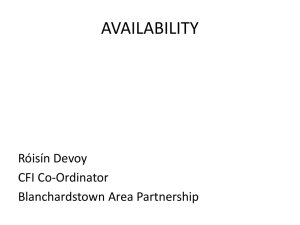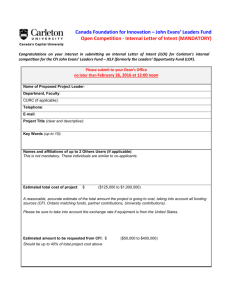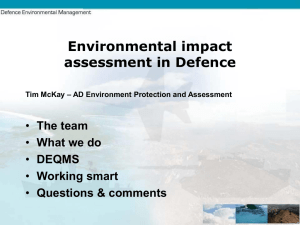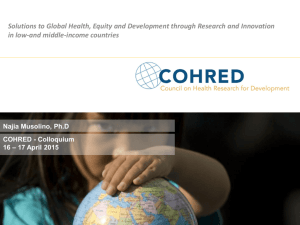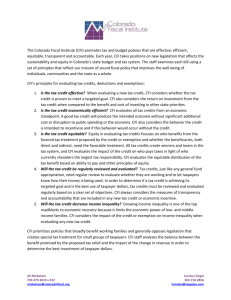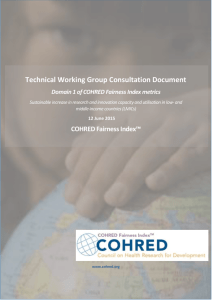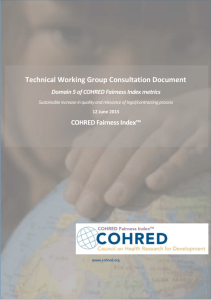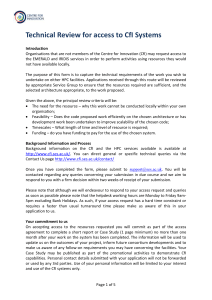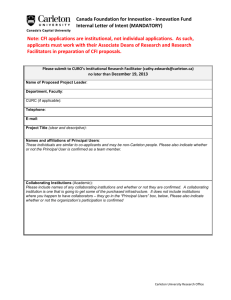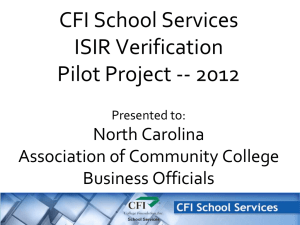Domain 4 of COHRED Fairness Index metrics
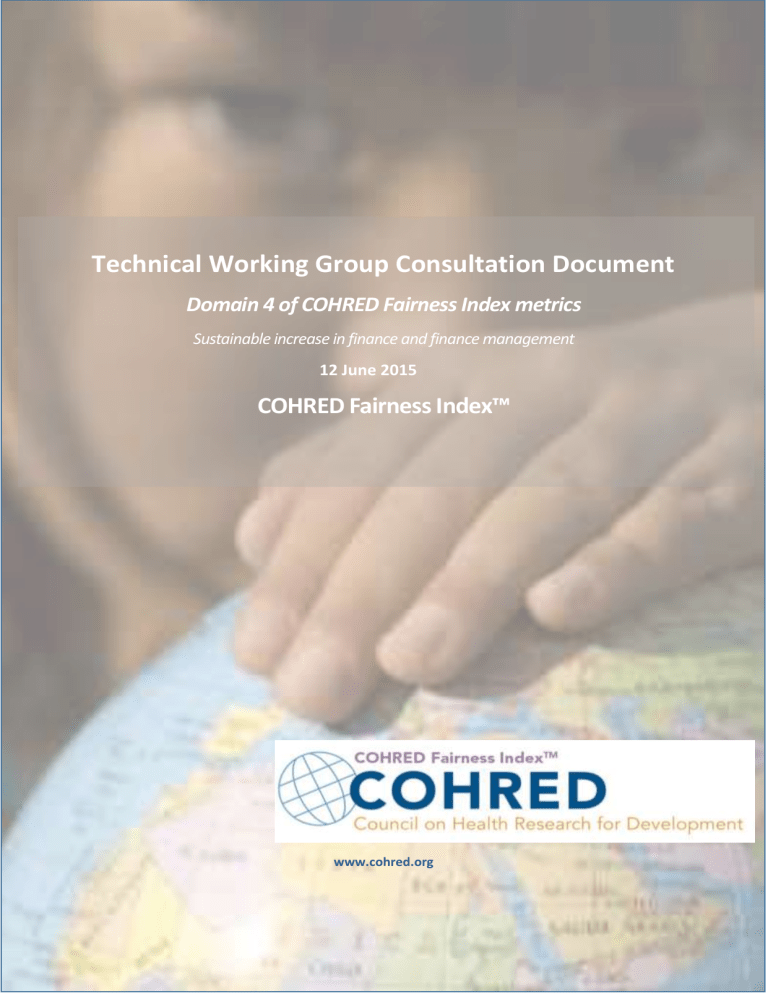
Technical Working Group Consultation Document
Domain 4 of COHRED Fairness Index metrics
Sustainable increase in finance and finance management
12 June 2015
COHRED Fairness Index™
www.cohred.org
Council on Health Research for Development (COHRED)
1 – 5 Route des Morillons
PO Box 2100 1211
Geneva 2 Switzerland
Tel: +41 22 591 89 00
Fax: +41 22 591 89 10
Email: cohred@cohred.org
www.cohred.org
COHRED Africa
P/Bag 00265 Plot 50654, Machel Drive Maranyane
House
(BOTEC) Gaborone – Botswana Tel: +267 399 6000 or
+267 399 6005 Fax: +267 399 6002
Email: mokgatla@cohred.org
africa.cohred.org
COHRED Fairness Index http://cfi.cohred.org
Contact: Najia Musolino musolino@cohred.org
Copyright and Fair Use
We are pleased to make this report freely available under a Creative Commons Attribution 3.0 Unported Licence (for conditions, see http://creativecommons.org/licenses/by-nc-nd/3.0/ )
You are free to share, to copy, distribute and transmit this work, under the following conditions:
You must attribute the work in the manner specified by the author or licensor (but not in any way that suggests that they endorse you or your use of the work).
You may not use this work for commercial purposes.
You may not alter, transform, or build upon this work.
For any reuse or distribution, you must make clear to others the license terms of this work. The best way to do this is with a link to the following web page http://creativecommons.org/licenses/by-nc-nd/3.0/ )
Any of the above conditions can be waived if you get permission from the copyright holder.
Nothing in this license impairs or restricts the author’s moral rights.
©Council on Health Research for Development (COHRED), Technical Working Group Consultation Document – Domain 4,
2015.
Suggested Referencing:
COHRED/Technical Working Group Consultation Document –Domain 4/12 June 2015
This document was prepared by the COHRED Core Writing Group:
Lauranne Botti, Assistant to the CFI Team
Carel IJsselmuiden, Executive Director of COHRED
Janis Lazdins, Associate of COHRED
Najia Musolino, Senior Specialist – Global Action for COHRED
Jacintha Toohey, Policy Project Adviser for COHRED
COHRED website: www.cohred.org
CFI website: www.cfi.cohred.org
Members of the (new and old) Technical Working Group:
Lola Adedokun
Pamela Andanda
Nelmara Arbex
Renata Curi
Jennifer Dent
Robert Eiss
Gerald Keusch
Kanyawim Kirtikara
Anatole Krattiger
Garry Aslanyan
Marième Ba
Prince Bahati
Thomas Bombelles
Eric Buch
Andrew Cherry
Glenda Gray
Sibongile Gumbi
Jens Hinricher
Suresh Jadhav
Rita Kabra
Jim Kaput
Jim Lavery
Glaudina Loots
Kevin Marsh
Charles Mgone
John Mugabe
Thomas Nyirenda
Jackie Olang
Merlita Opena
Teodora Padilla
Orakanoke Phanraksa
Cristiane Quental
Konji Sebati
Martin Sepúlveda
Nelson Sewankambo
Robert Fraser Terry
Jacintha Toohey
Rieke van der Graaf
Jack Watters
2 of 14
Executive Summary
On April 16-17 2015, COHRED hosted its fourth high-level Colloquium at the Wellcome Trust in London for an intense, focused and multi-sector discussion on the COHRED Fairness Index (CFI). A first series of 5 rounds of consultations with a Technical Working Group, followed by a global consultation, helped us produce a first report on the CFI for presentation at this meeting. Senior leaders from institutions that shape research and innovation for health attended the event and contributed to the discussions that were key for furthering the development of the CFI.
Following the Colloquium, a two-day CFI Team Strategy Meeting was held from 27-28 May 2015 at COHRED in
Geneva to discuss the five key domains of the CFI as well as the principles for each domain that were recommended for incorporation into the metrics of the CFI. These building blocks are presented in this document to the new Technical Working Group (TWG), where each TWG Member has been nominated to contribute to a particular domain based on the Members’ expertise. There are currently 5 small groups of 3-4 members per domain giving a total of about 15 members in the new TWG. In addition, 6 members have been requested to act as ‘overall reviewers of the TWG’ tasks. The names and details of affiliations of the members of the first TWG as well as the new TWG can be found on our website http://cfi.cohred.org/technical-workinggroup .
The objectives of this report are to:
1) Inform the TWG of the intention to change the name of the CFI through a global consultation process
2) Present the domains and principles for consideration by the new TWG and to elicit constructive and targeted suggestions to advance the preparation towards a final CFI model
3) Display the current stage of the CFI to TWG Members in preparation for the new Technical Working
Group Platform
4) Outline the steps that are planned before the launch of the CFI in October 2015.
The feedback from the TWG will allow the Core Writing Group to create the ‘ɣ’ Version of the Global
Consultation Document, which will be examined by 5 key stakeholder groups: National Research Bodies,
Industry, Government, Donors and Public Private Partnerships, and ‘others’ where appropriate. These separate stakeholder group consultations will lead to the ‘β’ Version of the Global Consultation Document, which will be used for the CFI implementation phase in October 2015.
The short-term goal of the CFI Team is to have 10 ‘β’ Versions implemented in (at least) 5 constituencies - preferably one in a high-income country (HIC) and one in a low-middle income country (LMIC) at country or institutional level. Each separate ‘β’ version will contain the building blocks that are most beneficial and relevant to each group. The Writing Group will then consolidate all ‘β’ versions for a final review by the new
Technical Working Group through a second Global Consultation phase before the launch of the certification system in October 2015. At this stage, we plan to monitor the ‘β’ version for 6 months before launch of the CFI in its start-up version by mid-2016.
In this second series of consultations with a TWG, the CFI Team is requesting your input on Domain 1 entitled
Sustainable increase in research and innovation capacity and utilisation in low- and middle-income countries
(LMICs). Similar short reports on Domains 2, 3, 4 and 5 have been distributed to other members of the TWG for review. We have asked each member to provide comments only on specific domains relevant to his/her expertise. For your convenience, we have provided in this report an example of a schematic outline of how we envisage building the metrics of the CFI for Domain 1. Please feel free to improve or modify the content.
In addition to this report, you will receive another 4 sets of similar documents each of about 5 pages long from now until October 2015 after which we will approach you again to enquire if you still want to be a member.
3 of 14
This report will require approximately 2 hours of your time to review. You are requested to provide comments by 19th June 2015 either directly by email or by phone.
We will reproduce aggregate responses only, never individual opinions unless you explicitly agree to a request we will make to identify you.
There are two very important notes about the application of the CFI:
1) The CFI can be constructed to measure 'aspects of partnerships directly' or to measure 'conditions that are essential or conducive to generate good partnerships', or both, of course. Measuring partnerships directly is complex as assessment will always need to include all partners in a research project.
For reasons of simplicity, therefore, the CFI will start by measuring 'conditions that are essential or conducive to generating and maintaining good research and innovation partnerships'.
2) The CFI can be applied at 'project/programme' level, at institutional / organisational / business level, at the level of national authorities, and/or at the international level.
For example, the CFI could certify that an individual contract is 'fair,' or that the organisations involved in the contract all have reasonable financial protocols in place - and is 'fair to all parties,' or that a national government has legislation or policies in place to encourage 'fair' research relationships, or that international organisations / PPPs / business engage in practices
that support research and innovation system building in LMICs.
We have decided that it is too complex and will require too large of an implementing infrastructure to consider certifying individual research contracts at the start of the CFI, but hold open to develop this in future.
For now, therefore, please consider your comments only in terms of applying the CFI to institutions/businesses/philanthropies engaged in research and innovation, and to national and international bodies dealing with research and innovation in any way.
4 of 14
Table of Contents
5 of 14
Abbreviations
COHRED
CFI
HIC
IP
LMIC
PI
REC
TWG
Council on Health Research for Development
COHRED Fairness Index
High-Income Country
Intellectual Property
Low- and Middle-Income Country
Principal Investigator
Research Ethics Committee
Technical Working Group
6 of 14
Relabelling the COHRED Fairness Index
Developing a global certification system like the COHRED Fairness Index (CFI) requires several phases and unavoidable alterations. Certain evolutions of the Index and chosen vocabulary have raised concern amongst stakeholders. Therefore, we intend to create a new, generic, descriptive and non-proprietary name and brand label of the CFI through wide consultation.
Definition
The COHRED Core Writing Group has created a new definition in order to meet the demands of various key stakeholders for the difficulty in measuring ‘fairness’ and ‘best practices.’ The proposed definition is as follows:
A certification system to promote and validate responsible/fair practices in international collaborative health research and innovation.
‘Responsible practices’ as a replacement for ‘fair’ and ‘best practices’ is a suggestion that is open to discussion.
COHRED will host a consultation on the CFI website ( www.cfi.cohred.org
) to determine whether the term
‘responsible’ or ‘fair’ are preferred by stakeholders and the public. On a similar note, the brand label of the CFI will change.
Brand Label
The current label, COHRED Fairness Index (CFI), has raised three major concerns amongst key stakeholders:
1.
The associated ownership of COHRED
2.
The term ‘Fairness’ and its measurability
3.
The term ‘Index’ and its suggestion of inevitable institutional ranking
Firstly, the CFI Team proposes to disassociate COHRED in the brand label as a means to encourage all users to adopt the certification system and gain stakeholder ownership. Secondly, the adequate term – whether it be
‘responsible,’ ‘sustainable’ or, decidedly, ‘fair’ – will be determined alongside the election of the system’s definition for coherence. Lastly, it has been established that ‘Certification’ or ‘Initiative’ will replace ‘Index,’ due to the possible reluctance of institutions to use the system in concern for consequential status awarding or demoting.
To conclude, an example could be: Responsible/Sustainable/Fair Collaboration Initiative (RCI/SCI/FCI).
Your comments or suggestions for a new name to replace ‘CFI’:
……………………………………………………………………………………………………………………………………………………………
………………………….…………………………………………………………………………………………………………………………………
…………………………………………………….………………………………………………………………………………………………………
……………………………………………………………………………….……………………………………………………………………………
………………………………………………………………………………………………………….…………………………………………………
…………………………………………………………………………………………………………………………………………………………….
7 of 14
Building Blocks of the COHRED Fairness Index
The certification system’s evaluation method is made up of a hierarchy of elements that will determine the degree to which collaborations are responsibly/fairly practised in health research and innovation. Figure 1 illustrates ISEAL Alliance’s framework that is applicable to any standard, and which COHRED has used as a basis for the structure of the CFI.
Figure 1. The building blocks from ISEAL Emerging Standards – Module 2: Setting Standards 1
Based on the elements of standard setting process of ISEAL Alliance, the following definitions are proposed for each building block of the CFI.
Objectives: Referred to in the CFI as ‘domains’. These domains are the agreed broad goals that are to be achieved through the certification system. (e.g. increase trust in partnerships)
Principles: Statements of desired outcomes. A goal can have more than one principle. (e.g. full financial disclosure to all signatories in a contract – could be one principle to increase trust)
Criteria: Conditions that need to be fulfilled for the principles to be achieved. (e.g. the lead institution has a protocol for transparency in financial information sharing prior to contract signature)
Indicators: Measurable elements that determine whether or not, or to what extent, the criteria are being fulfilled. (e.g. “Partnership Agreement” has a specific section requiring explanation of financial
transparency)
Means of verification: Information (sources) that will be used to obtain the data needed for indicators.
(e.g research administration record of lead institution should register this information)
NB. The example is purely hypothetical – aimed to clarify the hierarchy and logic of building up the CFI. It does not intend to convey that this example needs to be included in a final version.
Following the London meeting, we have now decided on 5 ‘Objectives’ or ‘Domains’. We now want to go further, and – with your help – move from ‘goal’ to ‘principles’, ‘criteria’, ‘indicators’ and ‘means of verification’. An overview of each of the 5 CFI domains is given below, as well as some of the principles that we will ask the TWG to reflect on and improve. The overview gives you a general view of what the CFI may look like – but what we wish to get your specific inputs on is on the domain in your area of expertise. That section and the questions related to it follows on this first overview.
1
ISEAL Alliance (2013). Module 2: Setting Standards. Available at: http://www.isealalliance.org/online-community/resources/module-2setting-standards-0 , Accessed on 3 June, 2015.
8 of 14
Overview of the COHRED Fairness Index – ‘ɣ’ Version
Domain 1: Sustainable increase in research and innovation capacity and utilisation in low- and middle-income countries (LMICs)
(Potential) Principle 1: Professional equity: This is the amount of standing and influence partners have vis-à-vis each other.
(Potential) Principle 2: Support for LMIC networks: Build positive long-term relationships through established networks to promote opportunities for collaborations addressing emerging challenges in global health and to encourage synergies in joint activities.
(Potential) Principle 3: Use local resources and knowledge: This is a direct reflection of local responsibility by helping keep resources well-managed for promoting systems setting the policies for governments.
Domain 2: Sustainable increase in research- and innovation-related benefits
(Potential) Principle 1: Intellectual Property (including ‘open access’): This has four elements (ownership of the
IP, access and use of the IP, rights and responsibilities attached to the IP, mechanisms available to manage and/or negotiate disputed issues around intellectual property rights).
(Potential) Principle 2: Post-research action 1) products 2) staff and facilities: Commitment from partners to ensure follow up especially with higher education institutions, with knowledge generated that can be made available for the benefit of the communities in low resource settings after a research activity is concluded. How are donor funded tools and sophisticated high-tech facilities put to the best use for the local populations and by the local experts? What is the continuity of the research after the end of research collaboration?
(Potential) Principle 3: Economic impact: Creation of jobs in academic and research institutions, Product
Development Partnerships and private companies for translation to country competitiveness and economic growth.
(Potential) Principle 4: Relevance to local health and equity solutions: Empowering local capacity to prioritise focused investment for priority health issues.
Domain 3: Sustainable increase in quality and relevance of ethical review
(Potential) Principle 1: Duplication vs. Replication in Research: Avoiding unethical wasting of resources.
‘Replication’ is needed to test interventions in several different environments; ‘Duplication’ concerns
‘marketing’ more than ‘knowledge generation’.
(Potential) Principle 2: Use and growth of local review capacity: Significantly improve the influence of local review to ensure that it is viewed, acted and respected upon by as many stakeholders as possible.
(Potential) Principle 3: Use of recognised guidelines/SOPs/accreditations: Harmonising valid application of standards by partners throughout the duration of collaboration with a purpose to implement directives laying down principles for good practices.
(Potential) Principle 4: Research Ethics Committees (REC) <-> chair of institutions: Membership of institutional ethics review committees do not have membership of the institutional executives.
Domain 4: Sustainable increase in finance and financial management
(Potential) Principle 1: Return on investment: Profitability ratio gauged by performance of the business, return on the owner’s equity and capital investment, production of new and useful knowledge.
9 of 14
(Potential) Principle 2: Equity in financing: Financing of partnerships adjusted to economic indicators. Low – middle income countries cannot compete with high-income countries in complementary funding (a million dollar to a high income country is not the same as a million dollar to a low or middle income country.
(Potential) Principle 3: Financial accounting standards: Monitoring of in-flow and out-flow of funds, transparency on use of overhead funds.
Domain 5: Sustainable increase in quality and relevance of legal/contracting process
(Potential) Principle 1: Do contracts reflect partners’ freedom to contract in terms of issues in global health research [i.e. contracts must reflect all partners’ interests in terms of key issues covered in global health research – such as intellectual property rights, institutional capacity building, technology transfer, data
ownership and samples, compensation for indirect costs, and authorship].The aim is to increase the quality of contracts to reflect fair and responsible practice, which are not against public policy and impropriety/harm is minimised.
(Potential) Principle 2: What are the effects of the contracts and where does onus lie: contracts must reflect the partners’ intention to create obligations, they must be lawful, enforceable and reasonable, and they must not be vague. The aim is to increase contracts relevance and enforceability by all partners and that both the legal and financial capacity to enforce contracts are considered.
(Potential) Principle 3: Is the contracting process guided by adequate legislative and /or policy frameworks: the contract process must be supported by international/national/institutional standards. The aim is to increase legal, negotiating, contracting capacity/competence so that contracting processes are faster and efficient in order to reduce conflict and improve trust.
An example of Domain 1 is provided in the Appendix. Please note that the schematic diagram is only a suggestion for the structure of the certification system. The building blocks can be reworked based on the contributions or interests of key stakeholders.
10 of 14
Objective / Domain 4: Sustainable increase in finance and finance management
The fourth domain of the CFI is sustainable increase in finance and finance management. Numerous elements necessary for the creation of a responsible/fair partnership conducting health research and innovation depend on sustainable financial undertakings and procedures.
Principle 1: Return on investment
The proposed definition of the CFI requires partnerships in the field of health to earn their share and credit of the work produced, along with their return on investment such as owner’s equity and capital investment, production of new and useful knowledge.
Criteria 1: Please suggest……………………………………………………………………………………………………………………….
Indicator 1: Please suggest………………………………………………………………………………………………………..
Indicator 2: Please suggest………………………………………………………………………………………………………..
Indicator 3: Please suggest………………………………………………………………………………………………………..
Criteria 2: Please suggest……………………………………………………………………………………………………………………….
Indicator 1: Please suggest………………………………………………………………………………………………………..
Indicator 2: Please suggest………………………………………………………………………………………………………..
Indicator 3: Please suggest………………………………………………………………………………………………………..
Criteria 3: Please suggest……………………………………………………………………………………………………………………….
Indicator 1: Please suggest………………………………………………………………………………………………………..
Indicator 2: Please suggest………………………………………………………………………………………………………..
Indicator 3: Please suggest………………………………………………………………………………………………………..
Principle 2: Equity in financing
The purchasing power parity (PPP) of high-income countries (members of Organisation for Economic Cooperation and Development (OECD) and non-OECD) is known to be generally higher than that of middle income countries. While middle income countries have climbed from low income country status and have sufficient domestic and international private capital at their disposal, these countries cannot yet compete with highincome countries for complementary funding to achieve developmental goals through international collaborative partnerships. Equity in partnership may not be the same as equal financial contribution.
Criteria 1: Please suggest……………………………………………………………………………………………………………………….
Indicator 1: Please suggest………………………………………………………………………………………………………..
Indicator 2: Please suggest………………………………………………………………………………………………………..
Indicator 3: Please suggest………………………………………………………………………………………………………..
Criteria 2: Please suggest……………………………………………………………………………………………………………………….
Indicator 1: Please suggest………………………………………………………………………………………………………..
Indicator 2: Please suggest………………………………………………………………………………………………………..
Indicator 3: Please suggest………………………………………………………………………………………………………..
11 of 14
Criteria 3: Please suggest……………………………………………………………………………………………………………………….
Indicator 1: Please suggest………………………………………………………………………………………………………..
Indicator 2: Please suggest………………………………………………………………………………………………………..
Indicator 3: Please suggest………………………………………………………………………………………………………..
Principle 3: Financial accounting standards
The international standards on accounting management will be applied within the evaluation level of Domain 4 on finances in the CFI. These standards will allow for a global understanding in the field of health research and innovation, leading to more fluid communication channels on what is required and expected for institutions to be certified as financially sustainable, transparent, accountable and responsible/fair.
Criteria 1: Please suggest……………………………………………………………………………………………………………………….
Indicator 1: Please suggest………………………………………………………………………………………………………..
Indicator 2: Please suggest………………………………………………………………………………………………………..
Indicator 3: Please suggest………………………………………………………………………………………………………..
Criteria 2: Please suggest……………………………………………………………………………………………………………………….
Indicator 1: Please suggest………………………………………………………………………………………………………..
Indicator 2: Please suggest………………………………………………………………………………………………………..
Indicator 3: Please suggest………………………………………………………………………………………………………..
Criteria 3: Please suggest……………………………………………………………………………………………………………………….
Indicator 1: Please suggest………………………………………………………………………………………………………..
Indicator 2: Please suggest………………………………………………………………………………………………………..
Indicator 3: Please suggest………………………………………………………………………………………………………..
12 of 14
Appendix
Timeline of the development period – June to October 2015
June • Form new Technical Working Groups for intensive consultations
• CFI brand label change
July
• Determine CFI scoring methods
• Plan and execute CFI international workshops
• Form the new Technical Working Group Platform for stakeholder intensive discussions
Aug • 25-27 August: Formal Global Consultation 2
• CFI Session at the Global Health Forum, Philippines
Sep
• CFI pilots at the governmental and institutional levels
Oct
• Two 'β' Versions in use in 5 key stakeholders: Launch of the CFI
Figure A. Timeline of the CFI until its launch in October 2015
13 of 14
Break down of Domain 1 of COHRED Fairness Index
To facilitate review and input, a further breakdown of domain 1 is provided below as an example:
Sustainable increase in research and innovation capacity and utilisation in LMICs
Domain 1
Professional equity
Principle 1
The institution is listed as a partner on protocol and wants to be a PI
Criteria 1
The insitution is a co-author or a shared PI
Indicator 1
Support for LMIC networks
Principle 2
Etc.
Criterion 2
The HIC institution has access to LMIC contacts
Criteria 1
The collaboration involves LMIC institutions and uses their associations
Indicator 1
A paper by the institution is drafted out of a database
Means of Verification 1
Work produced has evidence of contribution by LMIC networks
Means of Verification 1
Use local resources and knowledge
Principle 3
The institution is aware of local practices and accommodates research and innovation for local solutions
Criteria 1
The collaboration involves local advancements in health for the final research and innovation product
Indicator 1
The local individual or institution is benefitted fairly for their contribution
Means of Verification 1
Figure B. The proposed CFI structure using Domain 1 as an example
14 of 14
